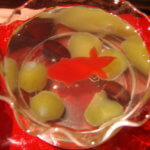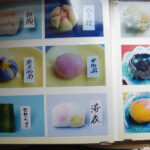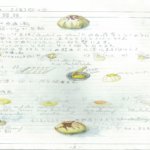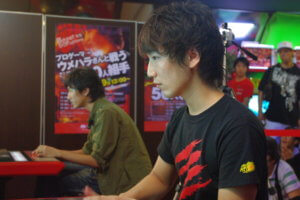Xenia Lavrow: Wagashi Chef Apprentice in Japan
CONTENTS
A YOUNG WOMAN FROM GERMANY CROSSES A CULTURAL BRIDGE AND FULFILLS HER DREAM AS A “WAGASHI” CHEF
Xenia Lavrowis from Dusseldorf, Germany. In high school, she took Japanese as a third foreign language and became interested in Japanese culture. In 2006, after graduation, she went to Japan for the first time at the age of 18. During her second visit three years later, she enrolled at Tsuji Institute of Patisserie in Osaka. She was enchanted by the charm of “wagashi,” a traditional Japanese sweet pastry. Upon graduation, her strong desire to learn wagashi-making in Kyoto led her to work and study at Korakuya wagashi shop. Xenia holds the Japanese Language Proficiency Test Level 1 certificate.
Xenia Lavrow has enjoyed the arts since she was young. She is skillful with her fingers and enjoys embroidery, too. But mostly she loves sweets – eating them and making them.
Fascinated by the beauty of wagashi
At Tsuji Institute of Patisserie, Xenia studied how to make both western-style pastries and traditional Japanese-style confectionaries, called “wagashi.” She was particularly fascinated by the beauty of wagashi, known for its array of unique colors and shapes as well as its skillful expressions of four seasons. At the institute, Xenia was told that it is very rare for a foreigner to even take the wagashi course.
(Read "Sense of Season Among Japanese People")
“Wagashi-making is difficult,” says Xenia. “It breaks easily, and it’s hard to create a good-looking piece, even when you really try. I re-make it many times, because we must provide identical pieces to our customers if they are to be marketable.
“Particularly difficult is the use of Japanese spatula, called ‘Hera,’” she continued. “Hera is indispensable in wagashi-making because it is used singlehandedly for many different tasks. This is very different from the western-style pastry-making, and I feel that it’s fascinating and quite esoteric. This kind of culture does not exist in Germany, so when I discovered the world of wagashi, it was very refreshing and enjoyable.”
Various challenges in Japan
Besides wagashi-making, Xenia experienced other challenges in Japan. “Communication was extremely difficult during my training at Korakuya,” she says. “This is probably unique to Japan, but I initially had a hard time making appropriate responses during conversations, or knowing whether certain expressions meant ‘yes’ or ‘no.’ How to speak over the phone in Japanese was also difficult.”
Xenia enjoyed the four seasons that could be expressed by the art of wagashi. But in real life, she felt some seasonal hardships. “It was very cold and hard during the winter and hot during the summer,” she remembers. “At the workplace where the wagashi was made, there was no heating and air-conditioning system to keep us comfortable. Particularly during the process of making ‘an’ (a Japanese bean jam), humidity, temperature and quality of ingredients must be taken into consideration to maintain consistent quality. Adjustments must be made on a daily basis. Despite those challenges, it was a very valuable experience because I could feel the effects of all four seasons on my own skin.”
One’s eagerness counts the most
Even though Xenia achieved the highest level of the Japanese Language Proficiency Test (Level 1) and has no difficulty in communicating in Japanese, some may doubt whether this foreigner is truly a productive asset to her workplace and whether she can work harmoniously with her Japanese co-workers. This is what Mr. Koichi Katsurada, owner chef of Korakuya wagashi shop, had to say: “It was the first time since the start of our business in 1949 that we worked together with a non-Japanese worker. During her training on how to make wagashi, I found it difficult to teach some subtle wagashi-making techniques to her, and sometimes I felt that she did not fully grasp my teachings. That was understandable, though, because our cultures and customs are fundamentally different, to say nothing of wagashi-making. However, Xenia was extremely eager and worked very hard. She was also adept with her fingers. After all, one’s eagerness is what counts the most. It does not matter if a person is a foreigner or Japanese; it’s up to the individual’s character and fortitude. Even though Xenia was young, she came to Japan with a strong desire to study wagashi at school. And upon graduation, instead of going back to Germany, she stayed in Japan to foster her career as a wagashi chef. I was struck by her enthusiasm and wholeheartedly accepted her at our shop. I think she is remarkable.”
Notes taken by Xenia substantiate her enthusiasm. During breaks at the shop or after coming home from work, Xenia writes down all that she learned that day in a notebook, similar to a diary. Because she is good at drawing, she includes detailed illustrations or drawings of ingredients or utensils she used. Her Japanese notes are just as solid as those written by native Japanese. They look like a manual for wagashi-making, and she has already managed to accumulate two volumes. Xenia says: “These notes are irreplaceable – a precious partner in life.”
Korakuya is an ordinary-looking wagashi shop, but its distinctive style is evident in its creative wagashi. The Korakuya has created more than 2,000 new kinds of wagashi so far. Their signature wagashi is called “Goldfish Bowl,” which is created and sold only during the summer season from June to August. “Goldfish Bowl” is being patented, according to Mr. Katsurada. “We had a strong desire to somehow re-create the image of a goldfish bowl, seen at summer temple or shrine festivals,” he says. “It took almost two years to produce it.” This unique and delightful wagashi, made only of agar-agar and “an,” is so cleverly created that everyone – young and old – can enjoy it. Each goldfish that swims in agar-agar is created individually by hand, so each one has a different color, pattern and shape.
How long is required to become a true wagashi chef?
It is said in Japan that it takes 12 years (one full cycle of Chinese astrological years) for anyone to become a true wagashi chef. Besides the high-quality staples that make their appearance every year, brand new creations adorn storefronts every season. It is not good enough for wagashi chefs to simply learn how to make these Japanese confections. They must develop a way to express their seasonal viewpoint, as well as having an “eye” for what is real. Xenia gives the following example: “Once, I went to a Shinto shrine and observed plum blossoms. At first glance, all of the plum blossoms looked the same. But depending upon the kind of plum trees, the blossoms and their number of petals are all subtly different. By observing real nature I have learned a lot, and making new discoveries is so much fun.”
Xenia completed her training in June, 2011. Today she says: “People pay attention to wagashi when they see that a foreigner is creating it. I will be so happy if Japanese people come to realize anew how wonderful wagashi is.”







One thought on “Xenia Lavrow: Wagashi Chef Apprentice in Japan”